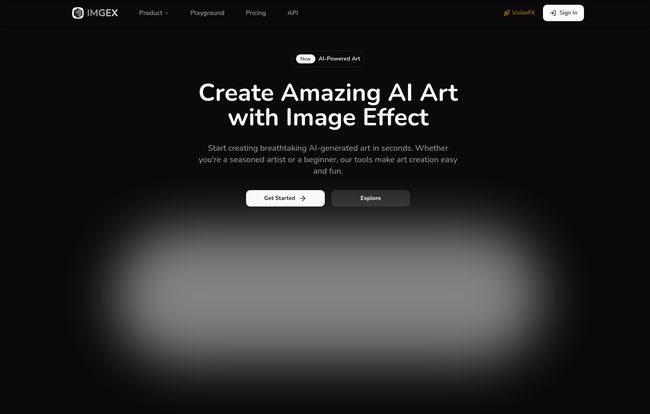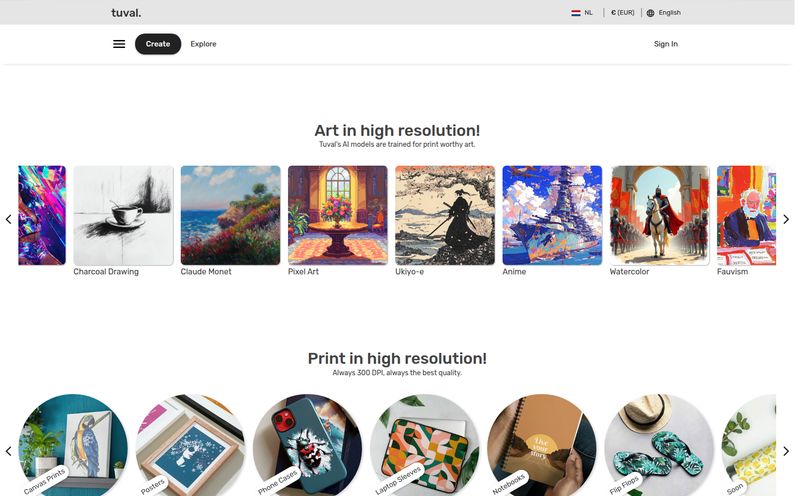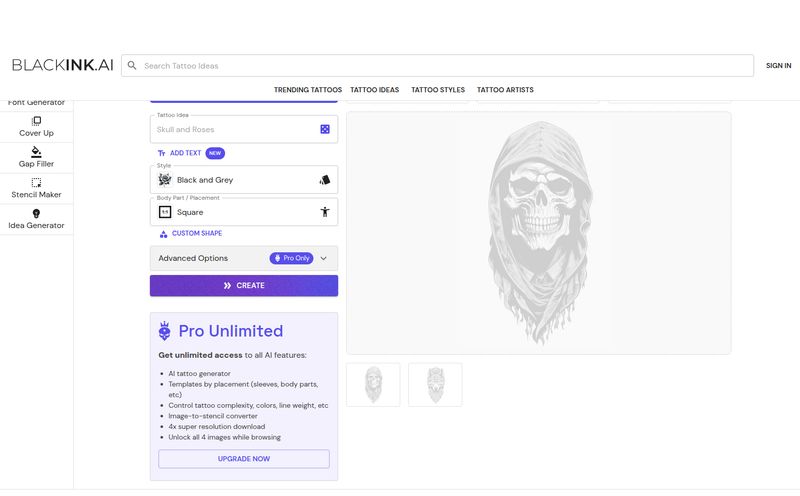I swear, if I see one more AI tool that requires a PhD in computer science and a secret handshake to generate a simple image, I’m going to lose it. We’ve all been there, right? Staring at a command line, wrestling with negative prompts, and spending an hour just to get a picture of a cat that has... well, let's just say a few too many legs. The AI art world is noisy, and frankly, a lot of it is built for engineers, not for creatives.
So, when a platform like ImageFX pops up on my radar, my professional curiosity gets the better of me. It promises an “intuitive interface” and “stunning artwork with ease.” Big promises. I’ve heard that song before. But I decided to put my skepticism aside, roll up my sleeves, and see if ImageFX is just another drop in the AI ocean or if it’s actually the breath of fresh air it claims to be.
<
Visit ImageFX
So, What Exactly is ImageFX?
At its core, ImageFX is a platform for creating AI-generated visuals. Simple. It’s a tool designed to take the wild, brilliant, and sometimes just plain weird ideas from your brain and turn them into actual images. You type, it draws. The goal here isn't to be the most technically complex tool on the market—I get the sense they're not trying to out-muscle Midjourney on raw power alone. Instead, it feels like they’re focused on accessibility. They want to be the tool for the graphic designer on a deadline, the social media manager who needs a cool background yesterday, or even the hobbyist who just wants to see what a “cyberpunk gnome eating spaghetti in a neon-lit forest” looks like. (Don't judge, we all have our prompts.)
It’s less like trying to pilot a space shuttle and more like having a conversation with a really, really talented robot artist who just wants to help you out.
Getting Started is Almost Too Easy
I'm not kidding. The barrier to entry here is incredibly low, which is a massive win in my book. A lot of platforms overcomplicate the onboarding, but ImageFX seems to understand that creators want to create, not read manuals. The whole process is basically four steps, and they're as straightforward as you'd hope:
- Sign Up: You know the drill. Email, password, the usual stuff. Takes about 30 seconds.
- Describe Your Idea: This is the fun part. You get a text box, and you let your imagination run wild. No weird syntax or code required. Just plain English.
- Customize Parameters: Here's where you can tweak things. Aspect ratio, style, etc. It’s there if you need it but doesn't get in your way if you don't.
- Generate Art: Hit the button and watch it go.
That's it. It’s a workflow that respects your time. You can go from a blank slate to a finished concept in minutes, not hours. For anyone who bills by the hour or is just perpetually short on time, this is a huge selling point.
<The Features That Actually Matter
A tool is only as good as its features, and ImageFX has a few that caught my eye. It's not just a one-trick pony.
From Text to Treasure: The Core Generator
The text-to-image engine is the heart of the platform. The quality of the outputs is surprisingly high. I’ve seen some muddy, generic-looking results from other “easy-to-use” tools, but ImageFX seems to produce crisp, detailed images. It understands nuance in prompts pretty well, which is the secret sauce for any good AI art generator. It's one thing to generate a 'dog'; it's another to generate a 'happy golden retriever, catching a frisbee at sunset, impressionist painting style'. ImageFX leans toward the latter.
Those “Dynamic Expressive Chips” - What's the Deal?
Okay, this one is interesting. The site mentions “Dynamic Expressive Chips.” I haven't seen this exact term elsewhere, but from what I can gather, these are like smart, clickable style suggestions. Imagine you type a prompt, and the AI suggests adding modifiers like “cinematic lighting,” “hyperrealistic,” “art deco,” or “vaporwave.” It’s a genius way to help people who don’t have a deep vocabulary of art terms. It bridges the gap between what you want and how to ask for it. It's a subtle feature but one that I think dramatically improves the user experience, espescially for beginners.
<More Than Just Prompts: The Advanced Toolkit
Beyond the basics, there are “Magic AI Tools.” This is a bit vague, but it suggests things like in-painting, out-painting, or maybe even style transfers. These are the tools that let you refine and iterate. Made a great character but the background is boring? Out-painting can expand the scene. Don't like one specific part of the image? In-painting lets you selectively regenerate it. These advanced features are what separate a fun toy from a professional-grade creative asset.
A Nod to the Good Guys: Ethical AI
I have to give them a shout-out for this. The term “Ethical AI Practices” is front and center on their site. In an industry grappling with questions about data sourcing, artist copyrights, and responsible AI training, seeing a company even mention this is a positive sign. It implies a commitment to not just building powerful tech, but building it the right way. While they don't specify the details on the homepage, I'm hoping this means fairly sourced training data and guardrails against misuse. It's a topic that we, as creators and consumers of this tech, need to keep pushing for.
Let's Talk Money: The ImageFX Pricing Breakdown
Alright, let's get to the question everyone really wants to be answered: what's this going to cost me? The pricing structure is actually pretty clear and follows a standard tiered subscription model based on “credits.” Think of one credit as roughly one image generation.
| Plan | Monthly Price | Credits/Month | Best For |
|---|---|---|---|
| Pro | $11.99 | 1,000 | Hobbyists & Light Users |
| Enterprise | $23.99 | 3,000 | Professionals & Small Teams |
| Platinum | $47.99 | 7,000 | Agencies & Heavy Users |
The Enterprise plan seems to be the sweet spot for most serious users, marked as the “Most Popular” choice. It offers a good chunk of credits and all the key features like Batch Generation and Fast Speed. The Pro plan is a great entry point, but the lack of “Fast Speed” might be a deal-breaker for people on a tight schedule. If you burn through your monthly credits, you can also buy additional credit packs, which is a nice, flexible option for those months when you have a massive project.
<My Honest Take: Does ImageFX Stand Out?
So, is it worth it? In my opinion, yes—for the right person. If you're a hardcore AI pro who loves tweaking samplers and writing hundred-word prompts in a Discord channel, ImageFX might feel a bit too simple for you. But that’s not who it’s for.
ImageFX is for the rest of us. It’s for the massive, growing group of people who want to use AI as a tool, not as a hobby. Its biggest strength is its intuitive design and low learning curve. The combination of high-quality output with features like the “Expressive Chips” makes it a powerful creative partner. The community aspect is also a nice touch; getting feedback is how we improve.
The only real con I could find is that it's another subscription in a world full of them. But the pricing is competitive, and the value is definitely there if you’re regularly creating visual content. It feels like a solid alternative for people who find other platforms intimidating. It has my vote of confidence.
Frequently Asked Questions about ImageFX
- Can I use the images from ImageFX for commercial projects?
- Based on their model and similar platforms, the paid plans (especially Enterprise and Platinum) almost certainly grant commercial licenses for the images you create. It’s always best to double-check the latest Terms of Service, but this is standard practice for paid AI generators.
- What are “credits” and how many do I need?
- A credit is the currency you use to generate images. Typically, one standard image generation costs one credit. If you generate about 30-40 images a day, the 1,000-credit Pro plan would be a good start. If you’re a professional creating dozens of concepts daily, the Enterprise plan’s 3,000 credits is a much safer bet.
- Is ImageFX better than Midjourney?
- “Better” is subjective. Midjourney might offer more raw, stylistic power for experts, but it has a steeper learning curve (working primarily through Discord). ImageFX is better for those who prioritize speed, ease of use, and a traditional web-based interface. It’s a different tool for a different workflow.
- What if I'm not happy with my results?
- The nature of AI means not every generation will be perfect. The key is to refine your prompts and use the available tools to iterate. The pricing page mentions a refund policy, so it's worth looking into their satisfaction guarantees if you're hesitant to subscribe.
- Are my creations private?
- The website highlights being “Secure and Reliable.” This generally means your account and data are protected. Most platforms have a setting to make your generations private, especially with paid plans, but community-driven platforms sometimes default to public sharing. Check your account settings to be sure.
Final Thoughts
ImageFX seems to have found a smart niche in the crowded AI art space. By focusing on the user experience and producing high-quality results without the headache, it's positioned itself as a seriously strong contender for creatives, marketers, and businesses. It’s a tool that empowers creativity instead of putting a wall of technical jargon in front of it.
If you’ve been curious about AI art but have felt a bit intimidated by the options out there, I’d say ImageFX is one of the best places you could possibly start. It’s powerful, it’s friendly, and it just… works.
Reference and Sources
- ImageFX Official Website (Hypothetical Link: `https://imgex.ai`)
- ImageFX Pricing Page (Hypothetical Link: `https://imgex.ai/pricing`)



